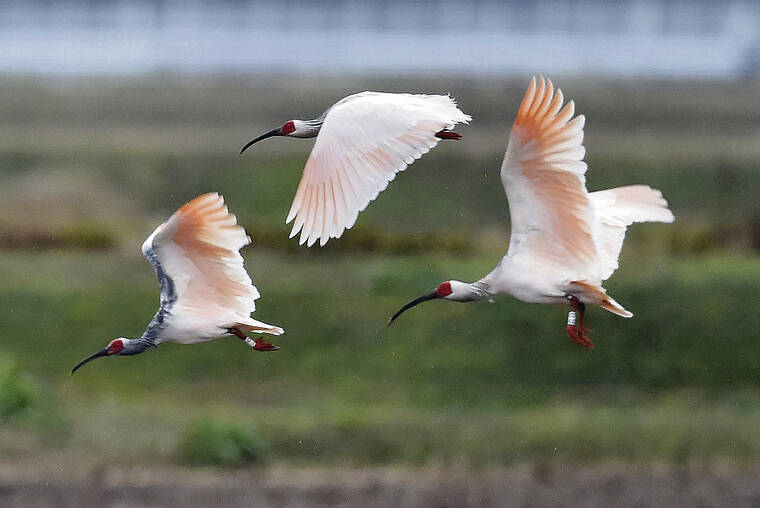Plan for returning crested ibis to wild takes off

JAPAN NEWS-YOMIURI / 2016
Though once common across East Asia, the Japanese crested ibis, or toki, was hunted to the brink of extinction during the Taisho Era (1912-1926). It was designated a special natural monument in 1952 and in 1960 was listed as an internationally protected species. Still, it was declared extinct 20 years ago. But artificially bred toki from China have been raised on Sado Island, Niigata prefecture; toki now numbers about 500. A flock of toki flies above Sado Island.
TOKYO >> This year marks 20 years since the endemic Japanese crested ibis, or toki, was declared extinct in Japan.
A program to artificially breed toki provided by China and release them into the wild on Niigata prefecture’s Sado Island, the last natural habitat of the long-winged bird, has been successful, with their numbers now estimated to be more than 500.
But the Environment Ministry has another goal: for the bird to survive in the wild on Japan’s mainland, the islands of Hokkaido, Honshu, Shikoku, and Kyushu. One challenge is figuring out how toki can coexist with humans.
In May and June, the ministry solicited local governments to host the bird in two environments, a reserve where it would be returned to the wild and a site shared with humans that could provide a stress-free landing spot during migration.
Three regional coalitions applied: Niigata prefecture and five of its municipalities, including Nagaoka; Ishikawa prefecture and nine municipalities on the Noto Peninsula; and Izumo, Shimane prefecture.
Initially, Niigata was considered the top candidate. Nagaoka already houses a toki breeding center, and Sado Island is a site where toki have been released since 2008. But the group withdrew its application in December.
Don't miss out on what's happening!
Stay in touch with breaking news, as it happens, conveniently in your email inbox. It's FREE!
“Farmers in the proposed area voiced more opposition than we expected,” said Wataru Hoshino, head of the prefecture’s nature coexistence office. “They are already practicing environmentally friendly agriculture by reducing the use of pesticides and chemical fertilizers, and having to take further measures ahead of the release of the bird made them uneasy.”
Others voiced concerns about toki trampling on rice stalks in paddies. The response made it clear that reintroducing the bird on the mainland won’t be easy.
Selected for reserve locations are Izumo, areas of Ishikawa prefecture and its nine municipalities. Three areas in Tohoku and Kanto are to become sites where toki would be exposed to humans.
The sites will be ready for the birds in 2025. That includes addressing various threats.
At the Sado Japanese Crested Ibis Conservation Center on Sado Island, for instance, nine toki were killed in 2010 when a marten, a weasel-like mammal, broke into a cage. On the mainland, there are other potential predators.
“A non-native species of raccoon that is good at climbing trees could present a threat to toki nests,” said Shinsuke Koike, a professor at Tokyo University of Agriculture and Technology.
The Noto Peninsula, meanwhile, is the site of a large number of wind power facilities, where the spinning blades of wind turbines endanger birds that inadvertently fly into them.
Once common throughout East Asia, Japan’s toki population was pushed to the brink of extinction during the Taisho era (1912-1926) due to excessive hunting.
The toki was designated a special natural monument in 1952, and in 1960 it was listed as an internationally protected species. The last five toki in existence were captured for artificial breeding in 1981.
SACRED TREASURE
The adult crested ibis, or toki, is noted for its attractive plumage, and its feathers hold a unique place in Japanese culture.
The Sugari no Ontachi sword, a treasure of the Ise Grand Shrine, a Shinto shrine in Mie prefecture, is the perfect example. The sword’s handle bears the design of toki feathers, and when the shrine is rebuilt every 20 years, a new sword is also made.
“Protecting the toki in Japan is also important in terms of passing on traditional culture,” said Satoru Otowa, director of the shrine’s public relations.
———
Japan News-Yomiuri




